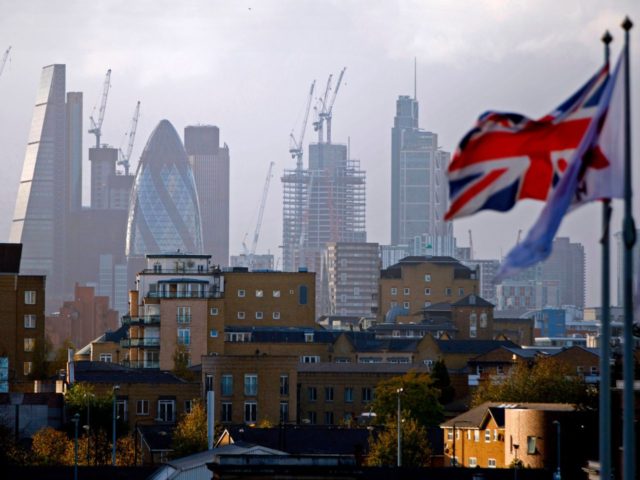The Bank of England has confirmed Britain’s financial institutions could withstand even the worst case scenarios offered by anti-Brexit campaigners, following a “stress test” report published this week.
On Tuesday the central bank said none of Britain’s major lenders would be unable to handle a theoretical recession brought on by a bad Brexit deal, and no government or tax payer funded bailout would be necessary.
The report comes on the back of months of “Brexit boom” stories, seeing Britain’s economic situation improving alongside investments in the nation and higher retail revenues, especially from tourism.
Lloyds, the Royal Bank of Scotland, Barclays, HSBC, Standard Chartered, Nationwide and Santander all passed the Bank of England’s tests, which include a whopping, pretend 4.7 per cent decline in UK GDP, alongside a rise in unemployment to 9.5 per cent.
According to reports, the test also includes an almost unimaginable 33 per cent fall in British house prices.
“The 2017 stress test shows the UK banking system is resilient to deep simultaneous recessions in the UK and global economies, large falls in asset prices and a separate stress of misconduct costs,” the Bank of England’s Financial Policy Committee said.
The Associated Press reports:
Britain’s biggest banks are strong enough to withstand a “hard Brexit” and could even weather a deeper recession than the one they struggled through during the global financial crisis nearly a decade ago, the Bank of England said Tuesday.
While concluding that lenders would still have enough capital to provide credit to households and businesses if Britain crashes out of the European Union without a deal, the Bank of England warned that the picture wouldn’t be so clear-cut if a so-called “disorderly” Brexit happens during a sharp global recession.
In its annual stress test of the sector, the central bank said the country’s biggest lenders, such as Barclays and Lloyds Bank, were “resilient” overall to adverse scenarios, including deep recessions at home and abroad and hefty falls in the price of assets
“Despite the severity of the tests, for the first time since the bank began stress testing in 2014, no bank needs to strengthen its capital position as a result,” Bank of England Governor Mark Carney said.
Stress tests have become a key policy instrument of central banks around the world since the global financial crisis. In Britain’s case, many of the country’s banks, including Royal Bank of Scotland, had to be bailed out by taxpayers at the height of the global crash in 2008 because they weren’t strong enough to cope with the shock.
In what is effectively a war-gaming exercise, the Bank of England tested banks’ ability to withstand a recession that was even worse than the one that took place after the global financial crisis nearly a decade ago.
Included in the test was the simulation of a 2.4 percent fall in global GDP, a 4.7 percent contraction in Britain, a 33 percent crash in the housing market crash, a further 27 percent fall in the value of the pound, which would take it well below one-to-one with the dollar, and a rise in interest rates to 4 percent from the current 0.5 percent.
In such a case, the Bank of England said banks would incur losses of around 50 billion pounds ($65 billion) in the first two years of the stress, the scale of which would have wiped out the underlying capital base of the sector ten years ago. Since the crisis, banks have been forced by regulators to boost their capital buffers, which they can draw upon in the event of a financial shock to satisfy the credit needs of individuals and businesses.
The central bank’s Financial Policy Committee, which monitors the stability and resilience of the banking system, also concluded that banks can continue to support the British economy in the event that the country experiences a “disorderly” exit from the European Union, which would see Britain crashing out of the bloc with no deal on future relations with the EU.
Britain is due to leave in March 2019 but negotiations with Brussels over the post-Brexit relationship have failed to make much progress, raising fears that tariffs and other restrictions would be slapped on British trade with the EU.
“We’re putting our money where our mouth is,” Carney said. “This is not a good scenario; it’s a scenario that we are all trying to avoid because it has some material economic costs even if financial system continues to function through it … There will be some pain.”
Carney warned that losses to the banking system would “likely be more severe” than in this year’s annual test if a “disorderly” Brexit takes place at the same time as a sharp global recession and banks are simultaneously hit with a series of fines such as those they’ve faced in past scandals involving the mis-selling of financial products.
“In this case, where a series of highly unfortunate events happen simultaneously, capital buffers would need to be drawn down substantially more than in the test and as a result, banks would likely need to restrict lending to the real economy, worsening macroeconomic outcomes,” Carney said.
Carney said the FPC will assess in the first half of next year whether the current requirement for banks to stash away 1 percent of their capital to protect against risks.
He says that the central bank’s central assumption is that the relationship between Britain and the EU will remain “highly cooperative.”
Carney has put his weight behind Prime Minister Theresa May’s proposal that a transition period, whereby Britain continues to trade with the EU largely under the same terms as now, is necessary after Brexit day. He said something between 18-24 months is the “minimum necessary” and that view is “increasingly appreciated on both sides of the Channel.”

COMMENTS
Please let us know if you're having issues with commenting.